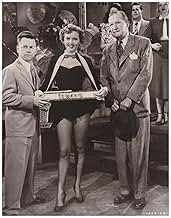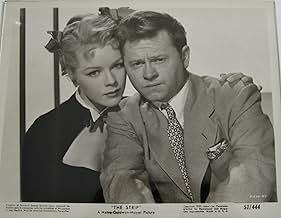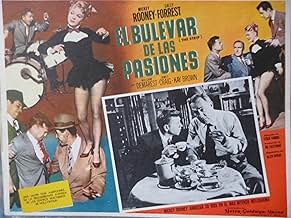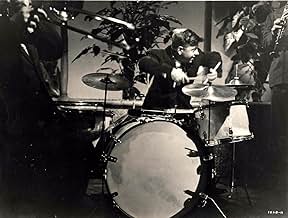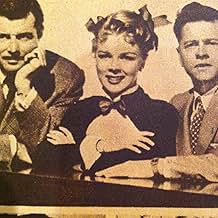IMDb-BEWERTUNG
6,1/10
825
IHRE BEWERTUNG
Füge eine Handlung in deiner Sprache hinzuDrummer Stanley Maxton moves to Los Angeles with dreams of opening his own club, but falls in with a gangster and a nightclub dancer and ends up accused of murder.Drummer Stanley Maxton moves to Los Angeles with dreams of opening his own club, but falls in with a gangster and a nightclub dancer and ends up accused of murder.Drummer Stanley Maxton moves to Los Angeles with dreams of opening his own club, but falls in with a gangster and a nightclub dancer and ends up accused of murder.
- Für 1 Oscar nominiert
- 1 Nominierung insgesamt
Joel Allen
- Boyfriend
- (Nicht genannt)
Don Anderson
- Club Patron
- (Nicht genannt)
Bette Arlen
- Dancer
- (Nicht genannt)
Empfohlene Bewertungen
The murder/suspense plot is little more than a convenient set of bookends to showcase the post-adolescent Mickey Rooney, Sally Forest and a gathering of jazz greats (Louis Armstrong, Jack Teagarden, Earl Hines, Vic Damone) in the setting of a Sunset Strip nightspot. James Craig isn't bad as the mustachioed "heavy" doting on his office foliage (after Dewey's defeat in '48, mustaches became quite unAmerican). This movie is neither fish nor fowl nor good red herring, and only marginally "noir" by virtue of date, setting and plotline, but it's watchable -- the music and dance numbers are pretty good. Like a couple of other films ("The Man I Love;" "Love Me or Leave Me") it gives evidence that a new genre might have been in formation: the musical noir.
Korea vet and aspiring drummer Mickey Rooney ('Quicksand') gets driven off the road by suave racketeer James Craig ('While The City Sleeps'). To compensate, Craig gives Rooney a job in his bookmaker's room. When the police bust in to the business, Rooney manages to escape and hitches a ride with Sally Forrest ('Mystery Street'), who works at a nightclub owned by William Demarest ('Night Has A Thousand Eyes'). Rooney pays the nightclub a visit and before he knows it, he's switched jobs from the bookie room to the drum kit and has fallen hard for Forrest. Forrest wants a movie career however, so Rooney introduces her to Craig, who has some contacts. But Craig isn't interested in helping Forrest, he just sees another pretty girl to add to his list of conquests. When Rooney confronts Craig about this things quickly fall apart, leading to Craig getting killed, and Forrest nearly dead, and Rooney as the prime suspect...
Told in flashback, the movie starts with the discovery of Forrest barely alive on her apartment floor, and during the investigation, the discovery of Craig's body and a gun. Rooney is brought in for interrogation, and he tells his side of the story in flashback. It all sounds like pure noir, until you see the movie, which is also in many ways a musical. Artists and musicians like Louis Armstrong, Vic Damone and Jack Teagarden are given plenty of time to play their music and sing their songs, as a large part of the movie plays out in nightclubs. In fact, one of the songs (sung by hatcheck girl Kay Brown) got the movie an Oscar nomination. Thankfully, unlike some noirs where musical interludes slow down the story, it works rather well here. And seeing Rooney and Forrest showing off their drumming and dancing skills respectively was way more fun than I expected, impressive stuff.
But a noir it still is, trust me. People use people and through the flashback structure, there is always tension under the surface as (part of) the outcome is already known to the viewer. And it has a bleak, downbeat, even ironic, ending that firmly establishes this as a noir. Performances are great across the board, helped by the well- written characters and dialogue. The main negative is that the directing by Laszlo Kardos ('The Tijuana Story') and cinematography by Robert Surtees ('Act Of Violence') is good but not very noir or imaginative. Still, that's only a minor quibble, this movie impressed me with its successful blending of noir and musical, the performances and the story. Recommended! 8/10
Told in flashback, the movie starts with the discovery of Forrest barely alive on her apartment floor, and during the investigation, the discovery of Craig's body and a gun. Rooney is brought in for interrogation, and he tells his side of the story in flashback. It all sounds like pure noir, until you see the movie, which is also in many ways a musical. Artists and musicians like Louis Armstrong, Vic Damone and Jack Teagarden are given plenty of time to play their music and sing their songs, as a large part of the movie plays out in nightclubs. In fact, one of the songs (sung by hatcheck girl Kay Brown) got the movie an Oscar nomination. Thankfully, unlike some noirs where musical interludes slow down the story, it works rather well here. And seeing Rooney and Forrest showing off their drumming and dancing skills respectively was way more fun than I expected, impressive stuff.
But a noir it still is, trust me. People use people and through the flashback structure, there is always tension under the surface as (part of) the outcome is already known to the viewer. And it has a bleak, downbeat, even ironic, ending that firmly establishes this as a noir. Performances are great across the board, helped by the well- written characters and dialogue. The main negative is that the directing by Laszlo Kardos ('The Tijuana Story') and cinematography by Robert Surtees ('Act Of Violence') is good but not very noir or imaginative. Still, that's only a minor quibble, this movie impressed me with its successful blending of noir and musical, the performances and the story. Recommended! 8/10
These types off film were being hammered out weekly in the 1950's. Superficially, there is little to distinguish this from the rest. However as it progresses, there is much to admire and enjoy. I love the format of an a hour and a quarter running time. Long enough to tell a simple tale, but without any time for padding, every frame counts.
Mickey Rooney is a fine character actor. One of the minor amusements here is watching a diminutive Rooney playing the lead, being dwarfed by everyone apart from his leading lady, Sally Forrest, who is probably the only actor on screen smaller than him! The premise of the loser/little guy who stands up for himself works well with several acutely observed scenes. The tragic denouement is a genuine surprise and is well told with clever editing keeping the tale skimming along at a brisk pace.
The musical,and song and dance interludes provide pleasing pauses in the action resulting in a film that ultimately delivers because it works so conspicuously within it's boundaries, rather than trying to push them.
Mickey Rooney is a fine character actor. One of the minor amusements here is watching a diminutive Rooney playing the lead, being dwarfed by everyone apart from his leading lady, Sally Forrest, who is probably the only actor on screen smaller than him! The premise of the loser/little guy who stands up for himself works well with several acutely observed scenes. The tragic denouement is a genuine surprise and is well told with clever editing keeping the tale skimming along at a brisk pace.
The musical,and song and dance interludes provide pleasing pauses in the action resulting in a film that ultimately delivers because it works so conspicuously within it's boundaries, rather than trying to push them.
If you like jazz, you'll like this one : there's a good part of this movie which takes place in Los Angeles' night-clubs with guest star Louis Armstrong. The story may look classical for a film noir, but the way it shows the story of a drummer penetrating in the underground world is surprising : watch it especially for the drum solos. Enjoyable !
Rootless kid (Rooney) goes to LA, hooks up with a smooth-talking mobster (Craig) and an ambitious nightclub dancer (Forrest), and gets into trouble as a result.
Despite its odd parts, this little b&w adds up to a pretty entertaining whole. The numbers from jazz legends Louis Armstrong and Jack Teagarden should please even those who don't much care for that style. Rooney of course is Rooney, a little man in a big man's world. No longer Andy Hardy, he was increasingly difficult to cast despite continuing popularity. Here his connection to mobster Craig is quite a stretch. Too bad the screenplay couldn't work out something more plausible. Nonetheless, his performances are never boring, plus he's a real firecracker on the drums.
And who's expert inspiration was it to stick roughneck William Demarist with the impossible name "Fluff". In my book, his avuncular nightclub owner walks off with the film. Sally Forrest makes for a convincingly ambitious Hollywood wannabe and romantic foil for Rooney. Looks like her movie misfortune was to be short and bouncy at a time when Debbie Reynolds was getting a hammerlock on spunk. Speaking of cute, did they have to make the wholesome girl (Kay Brown, I think) quite so achingly sweet and vulnerable.
Film is also a promo for nightspots along the Sunset Strip, where Vic Damone, for one, performs. And that's a few years before the big TV hit 77 Sunset Strip, which also exploited Hollywood nightlife. Location filming here adds atmosphere and a good glimpse of tinsel town, circa 1950 , along with the tuneful theme A Kiss to Build a Dream On. Anyway, in spite of real flaws, it's still an entertaining little film with a very appropriate ending.
Despite its odd parts, this little b&w adds up to a pretty entertaining whole. The numbers from jazz legends Louis Armstrong and Jack Teagarden should please even those who don't much care for that style. Rooney of course is Rooney, a little man in a big man's world. No longer Andy Hardy, he was increasingly difficult to cast despite continuing popularity. Here his connection to mobster Craig is quite a stretch. Too bad the screenplay couldn't work out something more plausible. Nonetheless, his performances are never boring, plus he's a real firecracker on the drums.
And who's expert inspiration was it to stick roughneck William Demarist with the impossible name "Fluff". In my book, his avuncular nightclub owner walks off with the film. Sally Forrest makes for a convincingly ambitious Hollywood wannabe and romantic foil for Rooney. Looks like her movie misfortune was to be short and bouncy at a time when Debbie Reynolds was getting a hammerlock on spunk. Speaking of cute, did they have to make the wholesome girl (Kay Brown, I think) quite so achingly sweet and vulnerable.
Film is also a promo for nightspots along the Sunset Strip, where Vic Damone, for one, performs. And that's a few years before the big TV hit 77 Sunset Strip, which also exploited Hollywood nightlife. Location filming here adds atmosphere and a good glimpse of tinsel town, circa 1950 , along with the tuneful theme A Kiss to Build a Dream On. Anyway, in spite of real flaws, it's still an entertaining little film with a very appropriate ending.
Wusstest du schon
- WissenswertesOne of several "fringe" musicals in the MGM canon, meaning dramas or comedies that feature one or more musical numbers, but not enough to qualify it as a proper musical. It actually includes a great deal of music, including several drum solos by Mickey Rooney, floor show routines by Sally Forrest, and songs performed by Vic Damone, Monica Lewis, Jack Teagarden, and Louis Armstrong, one of which would grow into a standard, "A Kiss to Build a Dream On". But the musical numbers all are presentational, as opposed to springing from the the plot, so the film is often bypassed by critics and historians in their discussion of movie musicals.
- PatzerThe cop says Jane's apartment's address is 1364 Quinlan. There is no Quinlan street in West Hollywood or anywhere else in Los Angeles County. However, this is not a goof as the movie is a work of fiction, and it is common to use fictitious locations in stories and movies.
- Zitate
Stanley Maxton: When I left the hospital, I was a Happy Jack. I-I had myself a set of drums and a jalopy. The sun was shining and the road to LA was good.
- VerbindungenFeatured in Los Angeles Plays Itself (2003)
- SoundtracksA Kiss to Build a Dream On
by Bert Kalmar, Harry Ruby, Oscar Hammerstein II
Performed by Louis Armstrong (uncredited)
Top-Auswahl
Melde dich zum Bewerten an und greife auf die Watchlist für personalisierte Empfehlungen zu.
Details
- Erscheinungsdatum
- Herkunftsland
- Sprache
- Auch bekannt als
- El bulevar de las pasiones
- Drehorte
- Mocambo - 8588 Sunset Boulevard, West Hollywood, Kalifornien, USA(Vic Damone's performance)
- Produktionsfirma
- Weitere beteiligte Unternehmen bei IMDbPro anzeigen
Box Office
- Budget
- 885.000 $ (geschätzt)
- Laufzeit
- 1 Std. 25 Min.(85 min)
- Farbe
- Seitenverhältnis
- 1.37 : 1
Zu dieser Seite beitragen
Bearbeitung vorschlagen oder fehlenden Inhalt hinzufügen


